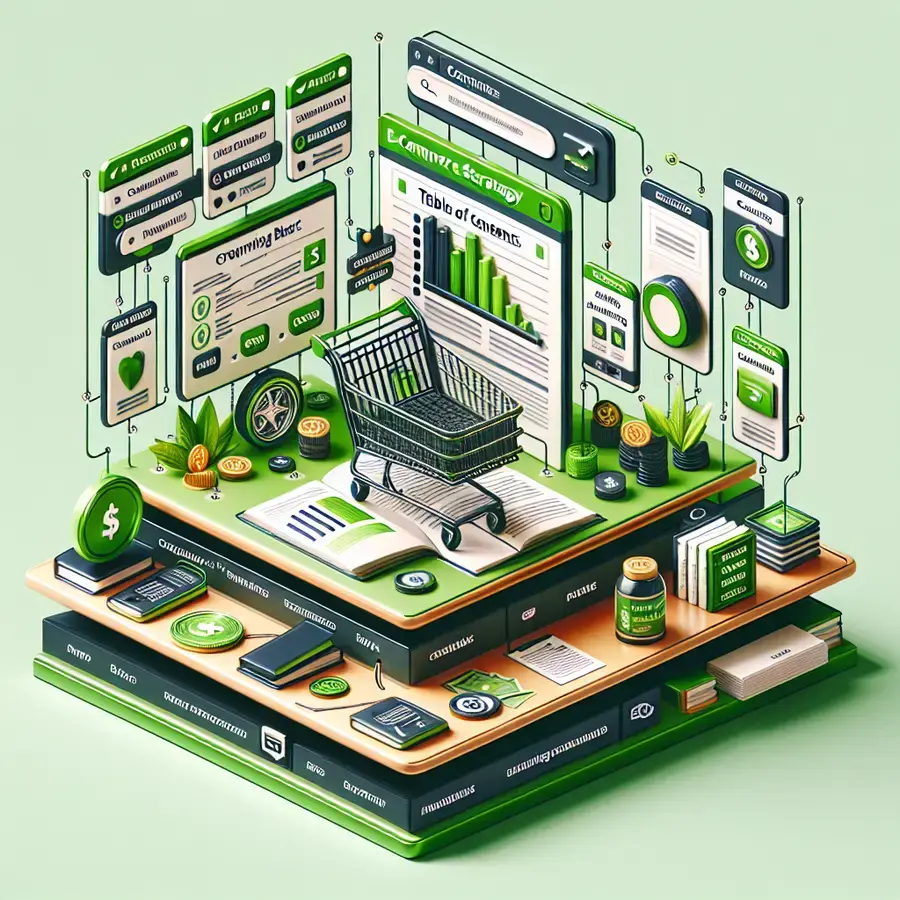Making Money from Shopify: Unlocking the E-commerce Potential

Did you know that Shopify powers over 1.7 million businesses in more than 175 countries, with a staggering $119.3 billion in annual sales? As the e-commerce landscape continues to evolve, entrepreneurs and business owners are turning to Shopify as a lucrative platform to monetize their passions. With years of experience in e-commerce and a proven track record of success, we’re here to share our expertise on how to make money from Shopify.
In this article, we’ll dive into the world of Shopify and reveal the strategies and techniques used by top earners to maximize their profits. Whether you’re a seasoned entrepreneur or just starting out, you’ll gain valuable insights and practical tips to help you succeed in the competitive world of e-commerce. Get ready to unlock the full potential of Shopify and start building a lucrative online business.
📚 Table of Contents

- Building a Profitable Shopify Store from Scratch
- How to Optimize Your Shopify Product Listings for Maximum Sales
- Shopify vs. Other E-commerce Platforms: Which is Right for You?
- The Financial Benefits of Using Shopify for Your Online Business
- Creating a Winning Shopify Marketing Strategy
- Understanding Shopify Fees: A Breakdown of Costs
- Leveraging Shopify Apps to Boost Sales and Revenue
- Measuring Success: Key Performance Indicators for Shopify Stores
- Shopify Store Design: Best Practices for Conversions
- Maximizing Shopify Sales with Effective Inventory Management
- Driving Traffic to Your Shopify Store: Proven Techniques
- Scaling Your Shopify Business for Long-Term Success
Building a Profitable Shopify Store from Scratch

To build a profitable Shopify store from scratch, you need to start by identifying a profitable niche. This involves researching products that are in high demand and have relatively low competition. Use tools like Google Trends and Amazon Best Sellers to find trending products.
Once you’ve identified a niche, it’s essential to conduct thorough market research to understand your target audience. This includes analyzing their buying habits, preferences, and pain points. Create buyer personas to help guide your marketing and sales strategies.
With your niche and target audience in mind, you can start building your Shopify store. Choose a theme that’s responsive and customizable, and optimize your product pages with high-quality images and detailed product descriptions.
- Ensure that your product pages are optimized for conversions by including clear calls-to-action and minimal distractions.
- Use high-quality product images from multiple angles to give customers a comprehensive view of your products.
- Make sure your product descriptions are detailed and include information about the product’s features, benefits, and any relevant technical specifications.
To drive traffic to your store, you’ll need to develop a comprehensive marketing strategy. This can include social media marketing, influencer partnerships, and paid advertising. Focus on the channels that are most likely to reach your target audience.
Finally, it’s crucial to monitor and optimize your store’s performance regularly. Use analytics tools like Shopify Analytics or Google Analytics to track your store’s traffic, sales, and conversion rates, and make data-driven decisions to improve your store’s performance.
How to Optimize Your Shopify Product Listings for Maximum Sales
Optimizing your Shopify product listings is crucial to increase visibility, drive sales, and ultimately make money from your online store.
Use high-quality product images that showcase your products from different angles, and consider lifestyle shots that demonstrate how the product can be used.
When it comes to product descriptions, focus on the benefits rather than just listing features, and use language that resonates with your target audience.
- Use relevant keywords naturally throughout the description to improve search engine optimization (SEO).
- Include customer testimonials or reviews to build trust and credibility.
- Keep descriptions concise and scannable to cater to customers who tend to skim through content.
Product titles are also critical, and should include target keywords to improve visibility in search results.
Make sure to set competitive prices by researching your competitors and understanding your target audience’s willingness to pay.
- Consider offering discounts or promotions to incentivize purchases.
- Use Shopify’s built-in features, such as price rules and discounts, to automate your pricing strategies.
By implementing these strategies, you can improve your product listings’ conversion rates and drive more sales through your Shopify store.
Shopify vs. Other E-commerce Platforms: Which is Right for You?
When it comes to making money from Shopify, choosing the right e-commerce platform is crucial.
Shopify is a popular choice among online store owners due to its ease of use, scalability, and extensive app ecosystem.
However, it’s essential to compare Shopify with other e-commerce platforms to determine which one best suits your business needs.
Key competitors include WooCommerce, BigCommerce, and Magento, each with its strengths and weaknesses.
- WooCommerce is ideal for WordPress users, offering seamless integration and flexibility.
- BigCommerce is known for its built-in features and scalability, making it suitable for large businesses.
- Magento is a robust, open-source platform that offers high customization, but requires technical expertise.
When evaluating e-commerce platforms, consider factors such as transaction fees, payment gateways, and shipping integrations.
Shopify’s pricing plans range from $29 to $299 per month, with transaction fees ranging from 2.4% + 30¢ to 0.5% + 30¢ per transaction.
Carefully assess your business requirements and budget to determine which platform offers the best value.
Ultimately, the choice between Shopify and other e-commerce platforms depends on your specific needs and goals.
The Financial Benefits of Using Shopify for Your Online Business
One of the primary financial benefits of using Shopify for your online business is the potential to increase revenue through streamlined sales processes. Shopify’s integrated payment gateways allow for seamless transactions, reducing cart abandonment rates and improving customer satisfaction.
Shopify also offers a range of features that help you manage your finances more effectively, including automated inventory tracking and reporting. This enables you to keep a close eye on your stock levels and make informed decisions about restocking and product offerings.
Another key financial benefit of using Shopify is the ability to scale your business more efficiently. Shopify’s scalable infrastructure supports high-traffic stores, ensuring that your website remains stable and responsive even during periods of rapid growth.
Some of the key financial benefits of using Shopify can be summarized as follows:
- Reduced transaction fees through Shopify Payments and other integrated gateways
- Improved inventory management through automated tracking and reporting
- Increased sales through streamlined checkout processes and optimized product pages
By leveraging these features and benefits, you can maximize your online store’s profitability and achieve long-term financial success with Shopify.
Creating a Winning Shopify Marketing Strategy
To create a winning Shopify marketing strategy, you need to start by understanding your target audience and their shopping behavior.
Identify your ideal customer by analyzing your existing customer data, including demographics, purchase history, and browsing patterns.
Use this information to create buyer personas that will guide your marketing efforts and help you tailor your messaging to resonate with your target audience.
- Research your competitors and identify gaps in the market that you can fill.
- Analyze their strengths and weaknesses to determine how you can differentiate your brand.
Develop a unique value proposition that sets your brand apart from the competition and communicates the benefits of shopping with you.
This could be a exclusive product offering, a loyalty program, or exceptional customer service.
Use social media to promote your brand and engage with your target audience, focusing on the platforms where they are most active.
- Share high-quality product images and videos to showcase your products.
- Utilize influencer marketing and user-generated content to build trust and credibility.
By following these steps, you can create a comprehensive Shopify marketing strategy that drives sales and grows your online business.
Understanding Shopify Fees: A Breakdown of Costs
When it comes to making money from Shopify, understanding the various fees associated with running a store is crucial.
Shopify charges a monthly subscription fee that ranges from $29 to $299, depending on the plan you choose, with the Basic Shopify plan starting at $29/month and the Advanced Shopify plan costing $299/month.
In addition to the monthly subscription fee, Shopify also charges transaction fees on every sale made through your store, unless you’re using Shopify Payments.
- The transaction fees range from 0.5% to 2% per transaction, depending on your plan, with the Basic Shopify plan charging 2.9% + 30¢ per transaction if you’re not using Shopify Payments.
- Using Shopify Payments can help reduce transaction fees, as it eliminates the need to pay extra transaction fees to Shopify.
Other costs to consider when running a Shopify store include payment gateway fees, which can range from 2.4% + 30¢ to 3.4% + 30¢ per transaction, depending on the payment gateway used.
Carefully reviewing your store’s fees and adjusting your pricing strategy accordingly can help you maximize your profits and make the most of your Shopify store.
Leveraging Shopify Apps to Boost Sales and Revenue
To maximize your Shopify store’s potential, it’s essential to explore the vast array of Shopify apps available. These apps can help streamline operations, enhance customer experience, and ultimately drive sales. By integrating the right apps, you can unlock new revenue streams and stay ahead of the competition.
One effective way to boost sales is by utilizing apps that offer personalized product recommendations. These apps use AI to analyze customer behavior and suggest relevant products, increasing the chances of upselling and cross-selling. By providing customers with tailored suggestions, you can enhance their shopping experience and encourage them to make more purchases.
Another key area to focus on is customer retention. Apps that enable you to create loyalty programs, offer exclusive discounts, and send targeted marketing campaigns can help foster a loyal customer base. By rewarding repeat customers and keeping them engaged, you can increase the likelihood of repeat business and positive word-of-mouth.
Some popular Shopify apps for boosting sales and revenue include:
- Product review and rating apps that help build trust and credibility
- Social media integration apps that enable seamless sharing and promotion
- Abandoned cart recovery apps that help recover lost sales and reduce cart abandonment rates
When selecting Shopify apps, it’s crucial to choose ones that align with your business goals and target audience. By doing so, you can maximize ROI and ensure that the apps you install are driving real results for your store. Always read reviews, assess the app’s functionality, and consider the developer’s support before making a decision.
Measuring Success: Key Performance Indicators for Shopify Stores
To determine the success of your Shopify store, you need to track and analyze key performance indicators (KPIs) that provide insights into your business’s overall health.
Revenue and sales growth are crucial KPIs to monitor, as they indicate whether your store is generating sufficient income and expanding its customer base.
Other essential KPIs include conversion rate, which measures the percentage of website visitors who complete a purchase, and average order value (AOV), which indicates the average amount spent by customers in a single transaction.
- Customer acquisition cost (CAC): the cost of acquiring a new customer, including marketing and advertising expenses.
- Customer retention rate: the percentage of customers who return to make repeat purchases.
- Cart abandonment rate: the percentage of customers who leave their carts without completing a purchase.
By monitoring these KPIs, you can identify areas for improvement and make data-driven decisions to optimize your store’s performance and increase revenue.
Regularly reviewing and adjusting your KPIs will help you stay on track with your business goals and make adjustments as needed to achieve success on Shopify.
Shopify Store Design: Best Practices for Conversions
A well-designed Shopify store is crucial for converting visitors into customers. A clutter-free and intuitive design helps build trust with potential buyers, making them more likely to complete a purchase. A clean design also improves the overall user experience.
To achieve this, start by selecting a theme that is optimized for conversions and is responsive, meaning it adapts well to different screen sizes and devices. Ensure your theme is compatible with various browsers to cater to a broader audience.
When customizing your theme, focus on creating a clear visual hierarchy. This involves using size, color, and positioning to draw attention to key elements such as promotions, new products, or calls-to-action.
- Use high-quality product images that are consistent in style and size.
- Optimize product images for fast loading to prevent slowing down your site.
- Consider using lifestyle images to show products in use.
Streamlining your navigation is also vital. Limit the number of menu items to avoid overwhelming visitors and make it easy for them to find what they’re looking for.
Another key aspect is the product page design. Include all necessary product information, such as detailed descriptions, pricing, and customer reviews, to help build trust and facilitate informed purchasing decisions.
Finally, ensure that your checkout process is as smooth as possible. Enable guest checkout to reduce friction for first-time customers and consider offering multiple payment options.
Maximizing Shopify Sales with Effective Inventory Management
Effective inventory management is crucial for maximizing Shopify sales, as it ensures that you have the right products in stock at the right time.
Accurate inventory tracking helps prevent stockouts and overstocking, both of which can negatively impact your sales and reputation.
To achieve this, you can utilize Shopify’s built-in inventory management features, such as tracking inventory levels and setting stock alerts.
- Set up automatic inventory updates to prevent overselling and reduce the risk of stockouts.
- Use Shopify’s inventory reporting to identify slow-moving products and adjust your stock levels accordingly.
- Regularly audit your inventory to ensure accuracy and detect any discrepancies.
By implementing a robust inventory management system, you can improve your order fulfillment rates and provide a better customer experience.
This, in turn, can lead to increased customer satisfaction and loyalty, driving repeat business and positive word-of-mouth.
Additionally, effective inventory management can help you reduce waste and minimize unnecessary costs, resulting in higher profit margins.
Driving Traffic to Your Shopify Store: Proven Techniques
To drive traffic to your Shopify store, it’s essential to have a solid understanding of your target audience and create content that resonates with them. Identifying your niche and tailoring your marketing efforts accordingly is crucial for attracting the right customers. This involves researching your competitors and analyzing their strategies.
One effective way to drive traffic is through Search Engine Optimization (SEO). By optimizing your product pages and blog posts with relevant keywords, you can increase your store’s visibility on search engines like Google. This includes using descriptive product titles, meta descriptions, and optimizing product images.
Another technique is to leverage social media marketing. Create business profiles on platforms like Facebook, Instagram, and Twitter, and share engaging content that drives traffic to your store. Utilize relevant hashtags and tag relevant influencers to expand your reach.
- Run targeted ads on social media platforms to reach your desired audience.
- Collaborate with influencers in your niche to promote your products.
- Share behind-the-scenes content to give your audience a glimpse into your brand.
Email marketing is also a powerful tool for driving traffic to your Shopify store. Build an email list by offering incentives like discounts or free shipping, and send regular newsletters to keep your subscribers engaged. This can include promoting new products, sharing exclusive deals, or offering loyalty rewards.
To further boost traffic, consider implementing a content marketing strategy. Create high-quality, informative content like blog posts, videos, or guides that provide value to your target audience. This can help establish your brand as an authority in your niche and attract organic traffic to your store.
Scaling Your Shopify Business for Long-Term Success
As your Shopify store grows, it’s essential to scale your business to achieve long-term success. Scaling involves more than just increasing sales; it’s about building a sustainable business model that can adapt to changing market conditions. This requires a strategic approach to managing your operations, marketing, and customer service.
One key aspect of scaling your Shopify business is to optimize your supply chain and logistics. This includes streamlining your inventory management, shipping, and fulfillment processes to ensure timely and cost-effective delivery of products to your customers.
To achieve this, consider implementing efficient inventory management systems, such as just-in-time inventory management or dropshipping. These strategies can help you minimize stockouts, overstocking, and reduce waste.
- Invest in inventory management software that integrates with your Shopify store to track stock levels and automate ordering processes.
- Consider partnering with a third-party logistics (3PL) provider to handle your shipping and fulfillment needs.
- Monitor and analyze your shipping data to identify areas for improvement and optimize your logistics operations.
Another crucial aspect of scaling your Shopify business is to invest in marketing automation. This includes using tools like email marketing software, social media management tools, and customer relationship management (CRM) systems to streamline your marketing efforts and improve customer engagement.
By automating routine marketing tasks, you can free up more time to focus on high-level strategy and growth initiatives. This can help you drive more sales, improve customer retention, and ultimately achieve long-term success with your Shopify business.


